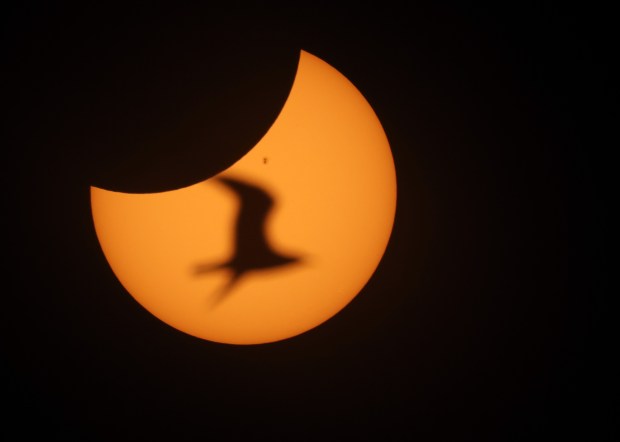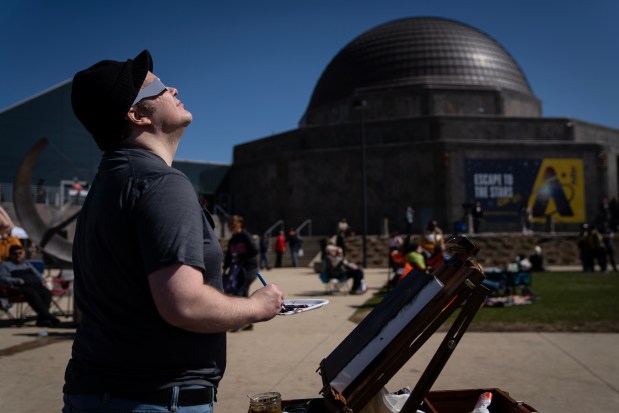They spent hours gathered with strangers on the concrete steps along Lake Michigan, letting their eyes adjust to the darkness. Shortly after 9 p.m., the starry sky lit up with shimmering waves of green and purple. On cue, amazed gasps and cheers rippled through the crowd as they celebrated having caught from the city a magical sight many travelers spend their lives chasing: the Northern Lights.
Last Thursday’s aurora display was a sky-gazing event accessible to millions across the country. Some may have missed the show due to timing or light pollution, but upcoming occurrences this week — a radiant comet back in the solar system for the first time in 80,000 years and the brightest, biggest moon of the year — offer similar awe-inspiring opportunities.
Looking up at celestial phenomena such as the Northern Lights can boost feelings of empathy and collective belonging, feelings many believe are in short supply as a sense of divisiveness marks this fraught election cycle. A record-high 80% of Americans believe the nation is divided.
“What we’re finding is that experiences that bring about awe and, most predominantly, really powerful fleeting experiences … seem to attune people and connect us to one another,” said Paul Piff, a social psychologist and professor at the University of California Irvine. “It connects us to what’s bigger than ourselves, motivates us to care for others and the greater good.”
In his research with collaborators, Piff found that after marveling at natural beauty such as scenic landscapes and observing heavenly phenomena such as the 2017 total solar eclipse, people report less entitlement and more selfless views. They also engage in kinder, more compassionate and empathetic behavior.
So far, this year has had no shortage of spectacles: The last two months each saw supermoons, the annual Perseids meteor shower put on a sparkly show in August, geomagnetic storms from sun activity also made the Northern Lights visible at lower latitudes in mid-May, and 99% of Americans witnessed at least partially the total solar eclipse that darkened skies in 15 states in April.
Starting Sunday, an age-old comet has become visible from the Northern Hemisphere as it approaches the sun. On Thursday night, the brightest full moon of the year will light up skies across the United States as Earth’s celestial companion gets almost 17,000 miles closer.
While the social effects of watching something awe-inspiring might only last for a month, experts say people who consistently seek out such experiences can benefit from longer-term positive impacts.
And the cosmic shows are far from over. As Election Day comes and goes, the next couple of months will offer dazzling comet and meteor shows — an active sun might even bring out the Northern Lights yet again — and with them, chances for anyone frustrated with an increasingly polarized America to feel a renewed sense of connection to humanity and the cosmos.
From awe to agreeableness

A Gallup survey in August found most Americans (80%) believe the country is more divided than ever before. In 2016, 77% saw the nation as divided and in 2004, that percentage was 65%. The survey also found that 74% to 83% of citizens from all backgrounds and major subgroups share this negative view of national unity, regardless of gender, age, race, political affiliation and educational attainment.
“This is just kind of the perception that is out there, and I’m sure that perception is informed by reality,” said Jeff Jones, senior editor at Gallup.
In 2023, a Gallup survey found that more than half of Americans believed the state of moral values in the country was poor, and a record-high 83% thought it was worsening. More specifically, respondents expressed the most discontent with how people treat each other.
On the national stage, that incivility has only increased as former President Donald Trump and Vice President Kamala Harris trade insults ahead of the November presidential election. Heated attacks, rude remarks and lies have become the norm in the highest echelons of government.
Piff said this kind of divisiveness and polarization is driven, in part, by psychological tendencies to view one’s own beliefs and attitudes as “the only right way toward truth.”
“American society is hyper-polarized. People feel like the other side — whatever the other side may be — is different, wrong, immoral,” Piff said. “We live in these increasingly curated and insular social worlds where we’re surrounded by people that either agree with us or people on the other side who seem so different and extreme.”
Experiencing something awesome can provide common ground for people who are entrenched in their own worldviews or feel apathetic toward others who think differently, according to Dacher Keltner, a psychology professor at the University of California Berkeley.
“The echo chambers, the repulsive rhetoric and the dehumanization of our times have really countered these broader tendencies to think: We’re a democracy, we’re meant to disagree, it’s healthy in the spirit of freedom and liberty,” he said.

In a 2021 study, Keltner and another researcher found that after people watched a nature documentary they felt less strongly about capital punishment, perceived the country to be less polarized regarding the existence of racial bias in the criminal justice system, and expressed a reduced desire to be socially distant from those with different viewpoints.
Piff explained that powerful natural phenomena can have a humbling effect on people, steering them toward agreeableness and social cohesion.
“When you experience or perceive something that’s so vast, so complicated, so powerful … it makes you feel like you need to reconfigure, readjust or update your mental schema, your understanding of the world,” Piff said.
In one of Piff’s studies, participants stood in a towering grove of some of the tallest eucalyptus trees in North America for a minute. Other participants were asked to look up at a comparably tall building for the same amount of time. After their respective tasks, a researcher approached both groups to hand out questionnaires and, in the process, faked an accidental stumble, dropping a bunch of pens on the floor.
Participants who had contemplated the trees bent down to pick up more of the dropped pens than those who had been asked to look at the building; researchers used the number of pens participants picked up to measure helpfulness.
And in the questionnaire that they subsequently filled out, participants who had viewed the trees reported reduced feelings of entitlement, saying they deserved less pay and disagreeing with statements such as “I honestly feel I’m just more deserving than others” or “If I were on the Titanic, I would deserve to be on the first lifeboat.”
Building on that study, Piff and other researchers studied the social effects of the 2017 solar eclipse, comparing the experiences of people in the path of totality — those who, directly under the moon’s shadow across the continental U.S. from Oregon to South Carolina, experienced complete darkness — versus people not in the path who saw a much less dramatic partial eclipse.
“Individuals who resided within the path of totality who experienced the eclipse in its fullness — and, you might say, its full awesomeness or its full power — exhibited more awe,” Piff said. “And as a result of that increased awe experience, they became less self-focused, less likely to talk about themselves.”
It was reflected in their language: Total eclipse viewers were likelier to use collective pronouns such as “we” and “us.” They also exhibited increased tendencies toward caring for others and collective well-being.
“When people experience awe,” Piff said, “the way that they define themselves, the terms that they use to define themselves, go from small social categories like ‘I’m a Californian’ or ‘I’m a Democrat’ to more inclusive social categories like ‘I’m a human,’ ‘I’m a member of the human species,’ ‘I’m a living organism.’”
Little communities

After the first big burst of the Northern Lights display Thursday, hopeful spectators who’d heard about it on social media rushed to the lakefront — a combination of amateur enthusiasts, seasoned skygazers and photographers with all kinds of expertise.
South Loop resident Sam del Rosario, 52, saw the show from Northwestern University Lakefill and Lighthouse Park. He has also chased the 2017 and 2024 eclipses that passed over southern Illinois. He said celestial events and his job as a hospice social worker have given him perspective.
“Those kinds of experiences, for me, are an intersection of … the hard sciences, something that is predictable, a culmination of human knowledge. But it’s also something that’s very emotional and very spiritual,” del Rosario said. “And I love when those things converge because it just shows how much we know, but also how much we don’t know.”
On the night of May 11, local photographer Josh Mellin headed to Museum Campus hoping to catch a glimpse and capture a shot of the Northern Lights, which had been visible from the city the night before. The crowd of similarly minded photographers dwindled after hours of fruitless waiting, and then it was “like a light switch turned on,” green fluttering and dancing across the sky. Everyone started screaming and shouting.
“We rolled the dice together. There was a community aspect to that, which I think drove us all to stay out,” he said. “You don’t get to meet up with people like that as often. It’s nice to just put (differences) aside.”
The group was on such a high of having experienced it together, Mellin said, that they weren’t ready to go back home to sleep. He headed to a bar for drinks and appetizers with three other photographers, two of whom he had just met, to wait for another possible burst forecast for 3 a.m.
Jones from Gallup polling said that dwindling association between people with different viewpoints is evident as more people now disapprove of marriage across political party lines: In 1958, 33% of Democrats and 25% of Republicans wanted their child to marry someone from the same party, according to Gallup data. In 2016, a political scientist asked a similar question and found that 60% of Democrats and 63% of Republicans wanted their child to marry someone from the same political party.

“It just kind of speaks to, politics has just been this very divisive force now, while in the past it was there, but it wasn’t quite at the same level,” Jones said. “You would have Democrats marrying Republicans, and they’d get along just fine.”
Since the dawn of time, humans have looked to the skies. Astronomy informed early navigation and the creation of the internationally recognized Julian calendar.
As director of public observing at the Adler Planetarium for three decades, Michelle Nichols has witnessed what she calls “little temporary communities” grow around telescopes and under “the sky we all share.”
It never gets old: “It’s the most remarkable thing,” she said.
“It’s a way to interact with folks who you’ve never met,” Nichols said. “I mean, we don’t ask people what their backgrounds are — we don’t care. We don’t ask people their political or religious affiliation — we don’t care. It doesn’t matter. It helps to connect us all as human beings.”
Lasting effects of everyday awe

After the solar eclipse in 2017, Piff and his fellow researchers documented awe-induced pro-social patterns of behavior returned to a baseline within a six-week window.
“That’s not to say that the effects are as fleeting as the eclipse itself,” he said, “but they seem to kind of go back to people’s normal, sort of default modes.”
Yet making a habit of more intentionally and repeatedly seeking out similarly awe-inspiring experiences — such as observing the night sky, a beautiful sunset or landscape — can sustain selfless, empathetic tendencies and overall mental well-being.
“Basically, one experience isn’t enough,” Piff said. “But if you orient yourself, learn to attend to the world in ways that bring about awe, which I think is a simple practice that people can do, then you’ll experience more of it, even in mundane or quotidian ways. And because of those more frequent experiences, you’ll experience a lot of its more long-lasting benefits.”
Keltner, who has authored a book about cultivating “everyday wonder,” said that listening to a powerful piece of music, looking at the night sky and reading about big ideas, including freedom of speech, “all have the potential of making us aware of our more common humanity, our shared concerns.”
Nichols from the planetarium said awe doesn’t necessarily have to come from witnessing a once-in-a-lifetime event such as a solar eclipse, which is rare and not as accessible to everyone.
She recalled a few years ago when, during an event in the Adler’s observatory, a woman approached a large telescope that was pointed at the moon and looked through.
“She was so excited, you could tell, and she stopped for a second,” Nichols said. “She backed up, sat down, and she started crying because it was so moving of an experience.”
“The mundane stuff is also just as impactful,” she added, echoing Piff.
It’s a matter of keeping an eye out for what’s happening and saying: “The universe has given me this, and I’m going to give it a try.”
Give awe a try
- Dubbed “comet of the year,” comet C/2023 A3 or Tsuchinshan-ATLAS, is speeding across the inner solar system and will be visible to the naked eye across the Northern Hemisphere through the end of October. According to NASA, the best time to spot it will be from Monday through Oct. 24 when it’s low on the western horizon shortly after sunset. The comet will rise higher each evening but appear dimmer. Comets are cosmic snowballs, which experts call “frozen leftovers” of dust, rock and ice from when the solar system was formed. As comets orbit closer to the sun, they heat up and their ice particles evaporate, trailing dust in a tail that can stretch millions of miles. They look like fuzzy balls with a wispy tail that points away from the sun.
- A newly discovered comet, C/2024 S1 ATLAS, is also approaching Earth and will be visible from the Northern Hemisphere beginning Oct. 28. If it survives its close encounter with the sun, it will be at its brightest before sunrise Oct. 29 through Oct. 31 — maybe even more so than Venus. It might also grow a big, curved tail.
- Thursday’s supermoon will be closest to Earth, only 222,055 miles away compared with its usual average distance of 238,900 miles. According to the Adler Planetarium, it will appear up to 30% brighter and almost 15% bigger than a full moon does at its farthest point.
- There’s still one more supermoon to see this year. On Nov. 15, the full moon will reach peak illumination at 3:28 p.m. and be around 225,000 miles from Earth. It will be visible from Chicago as it rises at 4:05 p.m. from the northeast.
- Traveling at 22 miles per second, as many as 120 bright, yellow meteors could be visible each hour at night on Dec. 13 through Dec. 14 as one of the largest and most reliable annual showers reaches its peak. The Geminids meteor shower is named after the Gemini constellation, from which they appear to radiate. While meteors are colloquially recognized as shooting stars, they are not caused by stars but rather rocks and metal bits, often from comets burning in Earth’s atmosphere when the planet runs into a trail of debris. In the case of the Geminids, which first began appearing in the 1800s, that debris comes not from a comet but from a small asteroid called Phaethon.



